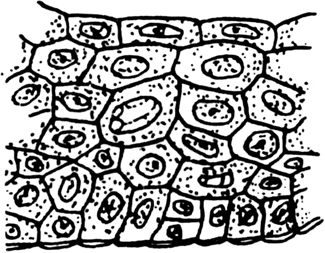Tissues
What are the various forms of cells of epithelial tissue? Describe briefly.
Following are the different types of epithelial tissue:
(i) Squamous epithelium. The cells of this tissue are broad, flat forming a pavement like appearance. They are of two types Simple squamous( having a single layer) and stratified squamous ( having many layers). It is found in the alveoli of the lungs. Bowmans capsule, membranous labyrinth of internal ear, peritoneum of coelom and blood vessels, skin etc.
(ii) Cuboidal epithelium. The cells of this tissue are cube like in appearance. They usually serve as gland cells. Cuboidal epithelium is called glandular epithelium when a portion of the cuboidal tissue moves inward and forms a multicellular gland. It is found in lining of kidney tubules and salivary glands etc.
(iii) Columnar epithelium. The cells of this tissue are more tall than wide, placed side by side. Their nuclei are situated near the bases. They may have on their free surfaces finger like projections—the microvilli. This tissue usually lines the internal surfaces of stomach and intestine.
Ciliated columnar epithelium. The cells of this tissue are modifications of columnar epithelial cells. They have on their free ends many small, vibratile cilia. These are found in kidney tubules, trachea oviduct etc.
A. Squamous. B. Cuboidal. C. Columnar.
Striated squamous epithelium.
Sponsor Area
Some More Questions From Tissues Chapter
What would happen if the plasma membrane ruptures or breaks down?
What would happen to the life of a cell if there was no Golgi apparatus?
Which organelle is known as the powerhouse of the cell? Why?
Where do the lipids and proteins constituting the cell membrane get synthesized?
How does an Amoeba obtain its food?
What is osmosis?
Carry out the following osmosis experiment:
Take four peeled potato halves and hollow each one out to make potato cups. One of these potato cups should be made from a boiled potato. Put each potato cup in a trough containing water. Now,
(a) keep cup A empty
(b) put one teaspoon sugar in cup B
(c) put one teaspoon salt in cup C
(d) put one teaspoon sugar in boiled potato cup D.
Keep this setup for two hours. Then observe the four potato cups and answer the following :
(i) Explain why water gathers in the hollowed portion of B and C?
(ii) Why is potato A necessary for this experiment?
(iii) Explain why water does not gather in the hollowed out portions of A and D.
By which instrument you can see internal structure of onion peel cell?
Do different organisms have different types of basic building units ? Briefly explain.
To what the shape and size of cells are related to?
Mock Test Series
Sponsor Area
NCERT Book Store
NCERT Sample Papers
Sponsor Area